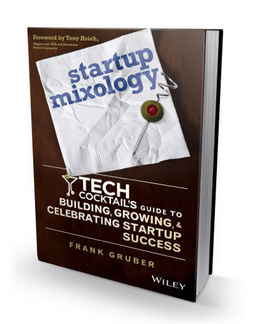Randi Zuckerberg's Blog, page 43
July 21, 2014
How to Fact-Check the News You Read Online
 In the wake of breaking-news events, social media goes haywire with first-to-respond reports and anecdotes. Online, anybody can call themselves a journalist. With a deluge of information, how do you know what you’re reading on the Internet is, well, real? These resources can help separate fact from fiction.
In the wake of breaking-news events, social media goes haywire with first-to-respond reports and anecdotes. Online, anybody can call themselves a journalist. With a deluge of information, how do you know what you’re reading on the Internet is, well, real? These resources can help separate fact from fiction.
Storyful’s Open Newsroom: Storyful’s global team of editors and journalists thoroughly verify social media updates in real time. Members are required to have an impeccable reporting track record, and every bit of news on the site is rights-cleared. The company’s recently launched Open Newsroom is a Google+ page where members can help vet information on breaking news.
Tin Eye: Like Google’s reverse image lookup service, Tin Eye can verify whether a photo taken from the scene has been previously posted or manipulated. Taking things a step further, the site also tells you where and how that image appears all over the web—even if it’s been modified. Just upload the picture or plug in its URL address to find out if it’s fake.
Checkdesk: Checkdesk is a live-blogging platform for staff and citizen journalists with built-in tools to fact-check breaking news in real-time. This technology makes it easy for newsrooms to embed verified social media content into their reporting, and lets journalists attach a status to their pieces, like “Verified,” “False,” or “In progress.” The beauty of this forum is its transparency.
For more online fact-checking services, check out the free Verification Handbook, funded by the European Journalism Centre.



 by
by 
The post How to Fact-Check the News You Read Online appeared first on Dot Complicated.
July 18, 2014
Would You Use an App to Monitor Your Mental Health?
 We use fitness and health tracking apps to gauge how many calories we burn and how much sleep we get at night. Now there’s an app that monitors your mental health.
We use fitness and health tracking apps to gauge how many calories we burn and how much sleep we get at night. Now there’s an app that monitors your mental health.
Startup Ginger.io analyzes smartphone behavior for signs of depression, schizophrenia, and other mental health issues, using your phone’s motion accelerometer and global positioning to measure where, how, and when you move. It records how long you spend idling and talking or texting as a means of gauging distress.
So how exactly does this work? MIT News interviewed the founder, Anmol Madan, about the ways Ginger.io can tell when a user’s smartphone behavior signals mental turmoil. “If someone is depressed, for instance, they isolate themselves, have a hard time getting up to go to school or work, they’re lethargic and don’t like communicating with others the way they typically do,” Madan says. “Turns out you see those same features change in their mobile-phone sensor data in their movement, features, and interactions with others.”
The opt-in program reminds users to reach out for human contact when it notices they haven’t talked to anyone all day, and can also alert doctors and relatives to downswings if they’re unable to make contact themselves.
While Ginger.io presents lifesaving benefits to individuals suffering from serious mental health issues, the thought of others monitoring your activity so closely—and making assumptions based on it—feels a tad creepy.
What do you think? Does Ginger.io seem like a good idea, or is this app too close for comfort?



 by
by 
The post Would You Use an App to Monitor Your Mental Health? appeared first on Dot Complicated.
July 16, 2014
How to Prepare Your Car for Summer Road Trips
With summer officially underway, many families are heading out on vacations, and that means road trips. Whether you’re taking a long-distance road trip or embarking on a simple weekend getaway, there are several things you can — and should — do to make sure your car is reliable, ready and able to make the trip safely. Following these suggestions could go a long way toward preventing a mid-trip breakdown.
Check out the tips below as you prepare for your summer road trip.
Recharging Air Conditioning
The hot summer temperatures require adequate air conditioning. Driving with the windows down won’t provide the same cool airflow. If you think your air conditioner is getting weak, it’s best to take the car to a mechanic to have them check it out.
Checking Tire Pressure
Striking the right balance of tire pressure is important when you’re hitting the pavement for a long trip. Generally, the tires should be close to their maximum inflation in summertime (as opposed to winter). However, be careful: if they are inflated too much, it could cause a blowout.
Getting an Alignment
Prevent a shaky or unstable ride by getting your tires properly aligned at your local auto shop. If you’re curious whether you need an alignment, look at the wear on your tire tread — if it looks uneven, or the tread is more worn on the outside, take the car to your mechanic. Or, check your owner’s manual for the manufacturer’s recommendations.
Changing Fluids
Adequate fluid levels ensure that your car functions at its best when racking up the miles. Check all of the fluid levels in your vehicle, including the engine oil, transmission fluid, antifreeze coolant, radiator coolant, windshield washer fluid and brake fluid. And, of course the most important: start out with a full tank of gas!
Replacing Belts, Hoses or Valves
These connector pieces keep your car running smoothly; have your mechanic check and replace these key components if necessary.
Put Together an Emergency Kit
Several key items everyone should have in their roadside emergency kit include jumper cables, a flashlight, multipurpose tool, tire sealant and duct tape. Also try to keep at least a quart of motor oil, a map/guidebook and a cell phone on-hand.
Plan Your Route
There are two pieces of tech savvy equipment that are great for helping you plan and follow your route. A global positioning system (GPS) uses satellite information to show you exactly where you are and how to get to your destination with easy-to-follow directions. Depending on the specific system you use, your GPS can also direct you to rest stops, gas stations and restaurants along the way, should you need that information.
A traffic alert app is also helpful for your commute; it will show you the fastest route and help you figure out the best time of day to leave on your trek, as well as your prospected arrival time. This may also come in handy when you return from vacation and get back to your regular work commute.
Equip Your Teen with the Right Resources
If your teen is taking an unsupervised road trip without you, make sure he or she has a safe journey. Certain new vehicles, like the 2014 Ford Escape, come packed with great features for teenage drivers. According to Kelly Blue Book, one of the safest features for young drivers is MyKey, which allows parents to designate a key that will limit top speed, limit audio volume or even disable the audio system altogether if the seatbelts are not buckled.
Your teen may find it annoying, but you can rest assured that he or she gets to their destination and back safely. In addition to the MyKey, the Escape also offers emergency braking assist, tire pressure monitoring and Airbag Deployment Notification.
Regardless of how many miles you plan on putting on your vehicle this summer, make sure you get to your destination safely with these tips.
Posted on 7/16/14
Written by Jennifer Thayer who is an editor at a technology blog called Freshly Techy. She enjoys covering other subjects like entertainment, food and deals. You can follow her on Twitter to see what useful tricks and fun tips she uncovers next.



 by
by 
The post How to Prepare Your Car for Summer Road Trips appeared first on Dot Complicated.
EAT, PRAY, EMOJI
I’m going to confess this right now – I love emoji. And I’m not alone. With a new emoji-only messaging app set to launch, it’s undeniable these little icons have made their way into the hearts, tweets and instant messages of social media users right around the world.
But before we take a look at how, and why, can we please get some technical stuff out of the way? Emoji and emoticons aren’t the same thing. Emoticons traditionally refer to facial expressions and symbols created from character combinations, where you type a semi-colon followed by a bracket to create your own smiley face. Emoji, on the other hand, are the predefined pictographs and icons we’re all adding to our smartphone keyboards that allow us to bring text-based messages to life with facial expressions, coloured hearts, a Halloween pumpkin, a spikey blowfish, and a chicken drumstick. So next time you message your friend a choc-chip cookie, a pair of bikinis, or a telescope, don’t call them emoticons. Rookie error.
Also, don’t go overboard. Three repeated emoji is the maximum needed to prove a point, and for your own sake, steer clear of the gun, bomb and volcano. They’re way too apocalyptic for day-to-day conversation. Unless of course it is the end of the world, in which case, go ahead and use whichever emoji you want.
So why are they so popular? In this internet age of decreasing attention spans, we’re always looking for shorter and more efficient ways to communicate – and we can do that with emoji. Best of all, they’re universal. No matter what language you speak, if your friend messages you a bowl of ramen soup, they probably want Japanese cuisine for dinner. If they use an American flag, chances are they’re patriotic and if they use a single red shoe… Well I have no idea what that actually means.
Overwhelmingly though, I believe their popularity lies in the power of visuals. As the old cliché goes ‘a picture tells 1000 words’ and that especially holds true in today’s digital world. All we have to do is look at recent web stats for picture-proof; Every day 350 million photos are uploaded to Facebook and 60 million images are posted on Instagram. Given we’re so drawn to images, when given the opportunity to use emoji in SMS, iMessage and WhatsApp, and on Facebook, Twitter and Instagram, it’s way too much fun to resist. Plus, expressing emotion isn’t always easy and emoji allow us to show how we feel without getting too deep. Blowing a kiss and sending a pink love heart are relationship savors for those of us who are emotionally unavailable.
Word of warning though: be cautious in your use because it’s easy to over-emoji. What starts as harmless fun in iMessage can become excessive. Do you relate? Do you believe emoji can express the full range of human emotions? Do you feel you need to exaggerate your emoji for impact? Or, do you find yourself enthusiastically inserting emoji into even the most mundane SMS? If you answered yes to any of these questions, my advice is to back away from your keyboard. I can help you, but first you have to help yourself, OK?
Globally, emoji are so popular that soon we’ll have emojli – a network where users can only communicate with, you guessed it, emoji – no text allowed. Thousands of people have already signed up to reserve usernames (myself included) which all have to be made from emoji. According to news reports, 250 new emoji are on the way as part of the Unicode 7.0 update, and even Seinfeld-inspired emoji have been created. That’s right – emoji representing Jerry, Elaine, George and Kramer (they will be named Jary, Gerge, Elane and Kragnor) – plus other characters and even classic episode icons like Junior Mints, a loaf of marble rye and pretzels (“These pretzels are making me thirsty!”).
As much as I love Seinfeld, and am already dreaming up ways to include an Elaine-inspired emoji into every message I compose, I’m hoping this won’t motivate heaps of companies and brands to get on the emoji bandwagon. I mean, I do think we’re missing some fundamentals. For example, it’d be awesome to have emoji for: fingers crossed, feeling ill, sarcastic, yellow brick road, selfies, Buffy, Star Wars, Kim Kardashian, Boo and Grumpy Cat. But as much as I want my own emoji addition wish list to come true, I don’t want to see our emoji vocab polluted with commercially driven reality TV talent show emoji and new fast food breakfast menu emoji. Because if we do get swamped, it’s inevitable that in an effort to cope with an overload of emoji, another new social network will launch that will ban the use of emoji altogether. And that would be a disaster. Sad face.
Posted on 7/16/14
 Jordana Borensztajn is a comedian, corporate speaker and social media trainer. She is also an emoji advocate. Tweet her emoji messages any time at @JordanaOZ, or connect with her using emoji on Instagram and Facebook. If Jordana doesn’t understand your emoji message, she promises to creatively interpret it. Smiley face.
Jordana Borensztajn is a comedian, corporate speaker and social media trainer. She is also an emoji advocate. Tweet her emoji messages any time at @JordanaOZ, or connect with her using emoji on Instagram and Facebook. If Jordana doesn’t understand your emoji message, she promises to creatively interpret it. Smiley face.



 by
by 
The post EAT, PRAY, EMOJI appeared first on Dot Complicated.
The Do’s and Don’ts of Kickstarter
Recently, aspiring chef Zack “Danger” Brown of Columbus, Ohio wanted to try making potato salad. His solution? Launch a Kickstarter campaign with a $10 goal for the culinary undertaking. The campaign has only been live for two weeks, and has raised a whopping $50,638 from more than 6,000 backers.
The Kickstarter has exceeded Brown’s wildest expectations, and it still has another 16 days to go. As the total amount raised has grown, Brown’s tacked on a few more goals: For example, he wrote that if the campaign hit $75, he would throw a pizza party. If you donate $1, and Brown will say your name while creating the potato salad and digitally thank you on the site. Give $20, and you’ll get a haiku inspired by the side, your name carved into a potato, a signed jar of mayonnaise, and the potato salad recipe.
We’re pretty sure this campaign is a joke, and it got us thinking about Kickstarter etiquette. Check out our list of the do’s and don’ts of crowd funding.
-The golden rule of crowd funding, of course, is that you donate to your backers’ future projects. Unless you’re morally opposed to the cause, backing the project with the minimum pledge is a courteous way to acknowledge their earlier support.
-Set a Realistic Funding Target. Your funding goal should be relatively easy to reach, but not too low that you’re not going to be taken seriously. Calculate a number that will allow you to move forward but is also low enough to meet at an early stage to get even greater support. Remember, there’s a large chunk of late adopters on Kickstarter who want to back projects that either have already succeeded or are likely to succeed.
-Don’t Complain That You’re Broke. Even if you’re not in a financial situation to make a video or offer thank-you gifts for donations, you should sound confident about your project. Avoid campaign language like, “I have no money” or “It will be a miracle if this thing takes off.” The last thing people want to invest in is someone who sounds desperate.
-Do Your Homework. Look at what successful projects have in common (a solid idea, a stellar video, captivating copy, appealing pledge rewards, etc.), but also examine the failed ones. Learn from crowd funding mistakes at TheKickbackMachine.com.
-Don’t Launch in the Summer. OK, Zack Brown is evidence that some rules are made to be broken, but most people take vacations during the summer months. It’s a fact that less people visit the Kickstarter site—which means that less people will see your project page.



 by
by 
The post The Do’s and Don’ts of Kickstarter appeared first on Dot Complicated.
July 15, 2014
Apps Every Small Business Owner Needs
When a friend from college decided to turn his hobby of playing violin into a career, he got serious and incorporated his band as a registered business. Starting a small business is challenging enough for anyone, but for my friend it was even more so because frankly he’s more of a musician than a businessman. Along the way, I suggested a few apps to help grow his small business and keep it on track. Since these apps worked so well for him, they may help guide your small business, too.
For business travels
We all know how stressful it can be to organize multiple travel itineraries and keep contacts in the loop. An app like TripIt consolidates all of your travel arrangements into a single itinerary that you can access from your smartphone or tablet. Just forward all travel emails such as flight confirmations, hotel reservations or car rental arrangements to TripIt, and they’ll merge everything into one easy travel plan to use and share with your business contacts. You’ll also get weather updates, maps and directions with the free version of the app.
If you have more extensive travel plans in mind, upgrade to TripIt Pro. For $49 a year, this version offers additional features that make sense for frequent business travelers including mobile alerts for flight delays and cancellations, information about alternative flights and access to over 1,700 business lounges around the world. While TripIt Pro will save you time with travel updates, keep in mind that there are ways to save on miles too, such as using a good travel credit card. You can get ahead if you strategize your business travel from the start.
For tracking expenses
Traveling, buying supplies and paying vendors generate expenses; to keep track of them all, you can’t beat Expensify. This secure app works with your Android, Windows phone or iOS device to create expense reports, provide flight updates and track mileage using GPS. You can also track time spent on individual projects, analyze spending with colorful graphs and charts and scan up to 10 receipts a month for no charge. Expensify is free to individuals and individual contractors. As your business grows, you might want to upgrade to the team version at $5 a month per user, or the corporate version at $9 a month per user.
For customer payments
Accepting credit card transactions as a small business just got easier. The Square app uses a nifty card reader inserted into an iPhone, iPad or Android to let you accept credit and debit cards. Rather than charging a monthly fee, Square takes 2.75% from each transaction. There’s no contract or commitment. The cool thing is that you don’t have to be in your store or office to accept card payments. This is particularly useful if your business performs out-of-office services, such as home repairs or dog training, or if you sell merchandise from off-site locations. This app made it easier for my musician friend to sell CDs at gigs.
For employee payroll
Instead of doing piles of paperwork for every employee paycheck, the ZenPayroll app can streamline the process for you. As you pay employees and contractors via direct deposit or checks, the app also calculates payroll taxes and electronically pays them to the government. To keep track of payroll, the app syncs with popular accounting software such as QuickBooks. Additionally, employees can view records of past pay stubs and government tax documents. The app’s pricing varies by number of people in the company — if there are five people in the company, the monthly price is $45, and 99 people comes to $243.
These apps certainly helped my friend with the business side of his band, giving him plenty of time to devote to his music. If you find yourself spending too much time tracking expenses or organizing your business, consider using these apps too. Of course, for any small business, so much more is involved than payments and traveling, and there are many other small business apps out there to help with efficiency on everything from organization to time management.
Posted on 7/15/14
Alexandra Rice is a writer who loves talking about all things education. After living in the Mid-Atlantic, South and Midwest, she has finally settled down out West in San Francisco. When not thinking about education, Alexandra can be found at the beach, playing with one of the many dogs at her office, or searching for the perfect cup of coffee. Catch her on Twitter day or night at @Alexandra_Rice.
Company bio:
NerdWallet has been around since 2009, helping consumers make smart financial decisions. We cover the spectrum of consumer finance — banking, credit cards, education, health care, insurance, investments, mortgages, shopping, small business, travel — you name it. We’re Nerds who create great tools, crunch numbers, check the fine print and give consumers all the results — unfiltered and transparent.
NerdWallet has been featured by outlets such as CNBC, Entrepreneur, Forbes, Kiplinger, LifeHacker, The New York Times, Reuters, TIME magazine and The Wall Street Journal. Money Magazine has named NerdWallet the web’s Best Credit Card Site, and consumer advocates Clark Howard and Liz Weston have recommended NerdWallet’s products.



 by
by 
The post Apps Every Small Business Owner Needs appeared first on Dot Complicated.
July 9, 2014
The New Waterproof Kindle
 We thought it was pretty tough to improve upon the Kindle Paperwhite, but a company called Waterfi has just answered our beachside reading prayers with the waterproofed Kindle ($240). It looks and functions exactly like the ordinary Amazon version, but it’s coated with a clear gel, inside and out, that makes it immune to water damage.
We thought it was pretty tough to improve upon the Kindle Paperwhite, but a company called Waterfi has just answered our beachside reading prayers with the waterproofed Kindle ($240). It looks and functions exactly like the ordinary Amazon version, but it’s coated with a clear gel, inside and out, that makes it immune to water damage.
The Waterfi Kindle is shipped in the original Amazon packaging, and looks and feels like a slightly heavier rendering of the original e-reader. But because of Waterfi’s special treatment process, its Kindle Paperwhite is completely waterproof. You can bring it into the bathtub or use it in the middle of the ocean (it can actually be submerged in up to 210 feet of fresh or salt water). See the magic for yourself here.
Finally, we can e-read poolside without worrying about breaking our electronics.



 by
by 
The post The New Waterproof Kindle appeared first on Dot Complicated.
July 8, 2014
The Top 3 Mobile Apps for Road Warriors
Apps. We love them. We hate them. And for some of them, we don’t even use them. Nonetheless, the mobile app environment is still continuously growing. Every time you go to the app store on your cell phone, you’ll be greeted with the most popular apps and the rising stars at that current moment. However, it is always a challenge trying to find the best app to add to your collection of other apps. If you are a road warrior (someone who is constantly on the go) or someone whose most overused phrase is “Can we reschedule,” I hope this list of my top 3 favorite apps to keep you connected makes your life a lot easier.
1. Feedly
Feedly is my go-to news app for all things related to the tech industry and the marketing industry. As a “techie” and a passionate marketing student, I am always reading through this app to keep up to date on what is going on in the industry. However, Feedly is not just an app for marketers. Feedly has a multitude of topic pages that you can access. From cooking to entrepreneurship, Feedly will have a topic you are interested in more likely than not. In fact, some of Feedly’s topic pages include Business Insider magazine, The Economist, VentureBeat, National Geographic and even Mashable. I highly recommend this app for anyone who has a lot of difficulty keeping up with the news because of work.
2. Agent
Jumping across the spectrum of apps, I’d like to introduce Agent. For many road warriors out there, you may receive emails, text messages, or general calendar notifications at the most irregular time intervals during a given week. One of the most common stories I’ve heard from working professionals I’ve met is that they would typically receive notifications and emails that demand an immediate response between 12am and 3am. This is where Agent comes in handy. This app makes your phone even smarter because it turns off your phone when you are in meetings, asleep, or driving. As an added benefit, Agent also remembers where you parked and helps save your battery. In sum, this app helps balance your digital/real life balance by making sure your eyes get some well deserved rest.
3. HootSuite
Now, I know what you may be thinking. Why would I want an app that was built for businesses? Well… let me explain! For many road warriors, keeping connected with friends in real-time online can be a very huge challenge. As we get busier and busier, it becomes twice as hard to check in on what your network is doing on multiple social media platforms. HootSuite eliminates those issues by allowing you to schedule posts and access the different newsfeeds across the social media spectrum through one app. Currently, it supports Twitter, LinkedIn, Facebook, and Foursquare. For the Google+ users out there, do not worry. The HootSuite team is working on that. If you are struggling to balance the time you spend on the different social media platforms, be sure to download this app. In the end, these are just a few apps I use to make the time I spend on my smartphone efficient. If you agree or disagree with this list, please feel free to let me know! I’m always interested in learning about different apps in the mobile marketplace.
Posted on 7/8/14
 Li-Xing Chang is a 3rd year Business Administration student at the University of California, Irvine. He is passionate about new gadgets, marketing, entrepreneurship, and innovative ideas. On his free time, you can find him staying active, pursuing different hobbies, or trying out new restaurants. His biggest role model is Elon Musk and his favorite quote from him is: “ If something’s important enough, you should try. Even if the probable outcome is failure.” Follow Li-Xing’s blog at his LinkedIn and you can contact him at his Twitter handle: @LixingChang.
Li-Xing Chang is a 3rd year Business Administration student at the University of California, Irvine. He is passionate about new gadgets, marketing, entrepreneurship, and innovative ideas. On his free time, you can find him staying active, pursuing different hobbies, or trying out new restaurants. His biggest role model is Elon Musk and his favorite quote from him is: “ If something’s important enough, you should try. Even if the probable outcome is failure.” Follow Li-Xing’s blog at his LinkedIn and you can contact him at his Twitter handle: @LixingChang.



 by
by 
The post The Top 3 Mobile Apps for Road Warriors appeared first on Dot Complicated.
Tech to Help You Return to the Workforce After Having Kids
My sister was really lucky. After she had her daughters, she could afford to stay home for seven years, up until her youngest started kindergarten. Being a stay at-home mom was an experience she wouldn’t trade for the world, but when she was ready to return to work, she wasn’t sure how to break back in. I searched around and found a few apps that helped her navigate her return to the workforce. Hopefully, some of these can make a difference in your life as well.
Prepare to return
Before you fill out your first application, you’ll need an up-to-date resume. This can be kind of intimidating if you’ve been out of the workforce for a while. Thankfully, you won’t have to type your resume from scratch. Resume Builder (or Resume Builder Pro for $3.99 at Apple’s App Store), helps you create a professionally formatted resume from your phone. Just enter your information and the app takes care of the design and layout. Store the finished product on your phone to apply for jobs electronically or send it to your computer when you need to print copies.
Once resumes start bringing in job interviews, returning moms don’t have to worry about being out of practice when they use Interview Prep Questions. Designed to work like digital flash cards, this free Apple app helps you rehearse interview questions and view ideal answers to build confidence to face even the toughest interviewer.
Streamline your job search
Life with kids in the house can get so hectic that it’s hard enough to find time for a job search let alone pour through countless online job boards. JobMo works on iPad, iPhone and Android devices to find jobs from all the major employment sites — Monster, Indeed and more — and bring it to one place. Compare salaries, search jobs, learn about specific companies and send out applications from your mobile device. The app is free.
Find unadvertised jobs
You’ve probably heard that most jobs are never even advertised in public, which can really limit a returning mom’s chances of finding the right opportunity. But for $0.99, the HiddenJobs app reveals many of these opportunities by scanning media reports for announcements about companies that are expanding or otherwise in the news. The app says it has uncovered at least 4.6 million job leads since 2011.
Another app called LinkUp bases its approach off a robust search engine designed to sift through company job boards — filtering by keywords, location and individual employers. LinkUp works with iPhone, iPad and Android devices as well as desktop computers.
Sometimes it’s who you know
Networking is one of the most effective ways to find a job, but if you’ve been out of the workforce for a while, you can feel disconnected. You probably know more people than you think, though. Start with LinkedIn and check out expert advice on using it to make professional connections more productive.
Another platform to consider is CareerSonar, a free app on a mobile web platform that connects with your LinkedIn and Facebook accounts to identify people in your networks associated with companies where you would like to work. It also groups and ranks open jobs by the strength of your contacts.
When you need a change
Maybe you hated your old job and aren’t thrilled about returning to the same field. An employment break is the perfect opportunity for a career change, and time spent as a stay-at-home mom develops all kinds of new skills and interests. If you’re not sure of your path, there are several personality and career tests online and in app stores that have questionnaires (for free) to help connect you to careers that suit your preferences and personality. If you need a more detailed analysis, there are also options for more extensive testing packages at affordable rates.
Using apps helped my sister ease back into the working world. She discovered a passion for art after years of kitchen table projects with the girls, and she ended up changing careers. Now, she loves her part-time job teaching art at a private nursery school. The apps alone weren’t the source of her success, but they certainly helped her — and they can help you, too — get a start in the right direction when returning to the workforce.
Posted on 7/8/14
Alexandra Rice is a writer who loves talking about all things education. After living in the Mid-Atlantic, South and Midwest, she has finally settled down out West in San Francisco. When not thinking about education, Alexandra can be found at the beach, playing with one of the many dogs at her office, or searching for the perfect cup of coffee. Catch her on Twitter day or night at @Alexandra_Rice.
Company bio:
NerdWallet has been around since 2009, helping consumers make smart financial decisions. We cover the spectrum of consumer finance — banking, credit cards, education, health care, insurance, investments, mortgages, shopping, small business, travel — you name it. We’re Nerds who create great tools, crunch numbers, check the fine print and give consumers all the results — unfiltered and transparent.
NerdWallet has been featured by outlets such as CNBC, Entrepreneur, Forbes, Kiplinger, LifeHacker, The New York Times, Reuters, TIME magazine and The Wall Street Journal. Money Magazine has named NerdWallet the web’s Best Credit Card Site, and consumer advocates Clark Howard and Liz Weston have recommended NerdWallet’s products.



 by
by 
The post Tech to Help You Return to the Workforce After Having Kids appeared first on Dot Complicated.
Startup Mixology
“Startup Mixology is an inspiring guide to help take that leap in the right direction. Gruber’s advice on delighting your consumers and thinking like an entrepreneur is uniquely tailored to fit today’s modern, wired age” – Randi Zuckerberg
In writing your book, you interviewed many successful entrepreneurs. What was your favorite insight or piece of advice?
I think my favorite piece of advice comes from Bre Pettis, the CEO of MakerBot. I interviewed him at our Tech Cocktail Celebrate conference, and he talked about how obsessed he and his early team were with building robots. At one point, he sold all of his stuff to buy robot parts and thought, “I’m not letting this thing go until it eats me.” He told me: “If you’re not obsessed with your product, screw it, or don’t do it! . . . Kill it right now and get on to the next thing.” After eight-plus years as a founder, I totally understand him – if I weren’t obsessed with connecting communities and helping entrepreneurs enjoy starting up, I couldn’t survive.
Of the “17 key ingredients” for starting, growing, and running a business, which one do you think is least understood by entrepreneurs today?
Probably celebration. Over the years, I’ve come to realize that celebration is a completely underutilized tool for startups. By celebration I don’t mean huge parties or champagne popping, but recognizing the positive moments along the way. You can celebrate with a high five, an impromptu dance around the office, or a walk around the block. Taking a minute to pause and recognize the progress you’ve made so far gives you much more motivation to dive into the next task on your to-do list. But too many entrepreneurs glorify the long hours, lack of sleep, and burnout. Some don’t believe in recharging their batteries – even for a few minutes or a few hours – and that’s not sustainable.
What is the secret sauce for creating marketing delight?
It’s all about the product. Funny videos can only go so far – at the heart of it, you have to have a product that’s extraordinary and absolutely shareable, something that users couldn’t help telling their friends about. It was interesting to hear that Jason Fried, the cofounder of Basecamp, doesn’t put any money into marketing. It all goes into creating a better, more efficient, more elegant product. This is so tiny, but he mentioned to me that when a user forgets to name a list, it just becomes “Untitled list” – it doesn’t pop up some annoying error message. Those little things – the way a product just works - are what create delight. Then throw in a little personality and a little humor (we’re called Tech Cocktail, after all) and people are hooked.
You’re often called a digital nomad for your ability to take your work anywhere. How has this working lifestyle helped you lead a more productive or happy life?
No one ever said startup life was dull, but it can definitely be routine. Especially when you’re working long hours, you might not see much other than the four walls of your apartment and (if you’re lucky) an office. I’m even luckier because I’m forced to break out of my routine – sometimes I’m hosting one of our events in DC or Miami, or visiting in-laws on the coast of Maine, or hunkering down at our Vegas office. Plus, I get to meet tons of entrepreneurs and techies at our events along the way, and there’s nothing more inspirational than that.
Where can our audience learn more about your work?
They can get more information about Startup Mixology at ht tp://tech.co/book, check out our startup and tech coverage at http://tech.co or my personal website at http://frankgruber.co. Or follow me on Twitter @FrankGruber and @TechCocktailand Facebook at: http://facebook.com/techcocktail.
Posted on 7/7/14
 Frank Gruber grew up in the Midwest heartland and is an entrepreneur, new media journalist, and investor. He is the author of Startup Mixology: Tech Cocktail’s Guide To Building, Growing, and Celebrating Startup Success published by Wiley. He cofounded Tech Cocktail in 2006, which has grown into a hub for the creative class, offering tech-startup-focused news, events, and resources. Frank has built and launched products for the masses while at AOL, Tribune, and Classified Ventures along with startup efforts like Thankfulfor, Splog Reporter, and more. As a journalist, his works have been featured in a number of top media publications like TechCrunch, Fortune, HuffPo, etc. He was named by Forbes as one of the most connected people in tech. His alma maters include Purdue and Northwestern, respectively. While living the startup life, he also enjoys swimming, strumming his guitar and/or ukulele, warm weather, beaches, and sports – especially the Chicago Cubs.
Frank Gruber grew up in the Midwest heartland and is an entrepreneur, new media journalist, and investor. He is the author of Startup Mixology: Tech Cocktail’s Guide To Building, Growing, and Celebrating Startup Success published by Wiley. He cofounded Tech Cocktail in 2006, which has grown into a hub for the creative class, offering tech-startup-focused news, events, and resources. Frank has built and launched products for the masses while at AOL, Tribune, and Classified Ventures along with startup efforts like Thankfulfor, Splog Reporter, and more. As a journalist, his works have been featured in a number of top media publications like TechCrunch, Fortune, HuffPo, etc. He was named by Forbes as one of the most connected people in tech. His alma maters include Purdue and Northwestern, respectively. While living the startup life, he also enjoys swimming, strumming his guitar and/or ukulele, warm weather, beaches, and sports – especially the Chicago Cubs.



 by
by 
The post Startup Mixology appeared first on Dot Complicated.












